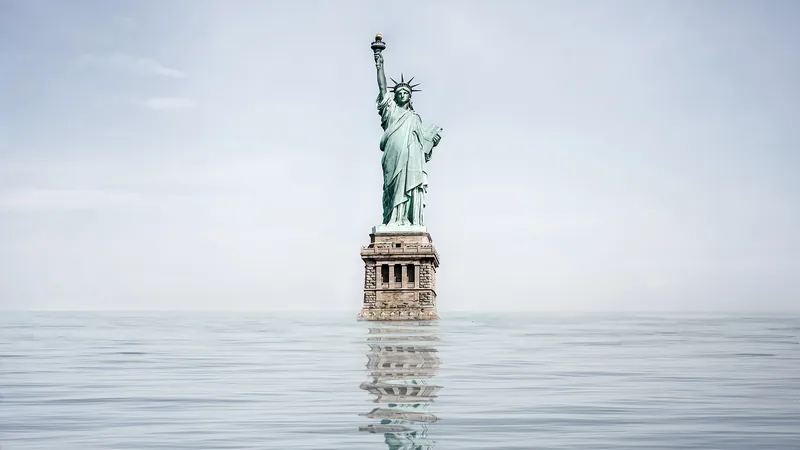
The Icy Truth: How a Hidden Antarctic Ice Sheet Could Shape New York City's Future
2025-04-22
Author: Li
On October 29, 2012, Superstorm Sandy unleashed a catastrophic 14-foot wall of seawater onto New York City, causing immense destruction and claiming 147 lives. This disaster wasn't just a freak occurrence; it provided a chilling glimpse into a potentially flooded future.
As climate change accelerates, the NYC Panel on Climate Change predicts that by mid-century, flooding akin to Sandy's devastation could become a routine threat. While landmarks like the Statue of Liberty may remain above water, the futures of low-lying areas like Ellis Island hang in the balance. Projections estimate a local sea-level rise of up to 2.5 feet by the 2050s and as much as 9.5 feet by 2100.
Ancient Cycles, Modern Consequences
Scientists are turning back to Earth’s distant past for insights into these alarming predictions. The Quaternary period, which started roughly 2.6 million years ago, has seen dramatic fluctuations between ice ages and warmer interglacial phases, shaping our planet’s sea levels. During these warm phases, ice sheets melted, lifting sea levels and leaving profound impacts on coastal regions.
One critical period is known as the Last Interglacial, occurring around 129,000 to 116,000 years ago, when global temperatures climbed about 1.8 to 3.6 degrees Fahrenheit above preindustrial levels. With current temperatures already 2.7 degrees Fahrenheit higher, we may be on the brink of similar climatic shifts.
Rethinking Ice Sheets: The Case of the Laurentide
Historically, researchers believed that North America’s Laurentide Ice Sheet vanished early on during the Last Interglacial. However, new findings suggest this massive ice sheet may have persisted much longer, meaning the melting of Antarctica could be both more extensive and rapid than previously thought, raising fears about future sea-level projections.
Roger Creel, a geophysicist, highlights the importance of understanding how Antarctica’s ice latest under similar temperature scenarios. If the models underrepresented Antarctic melt, current sea-level projections might be dangerously underestimated.
The Uncertain Path Ahead for Sea Levels
Since 1880, global sea levels have risen nearly a foot, with rates doubling since 2006. The scientific community continues to grapple with how much polar ice will melt and how fast, complicating any accurate sea-level forecasting.
While recent studies utilizing sediment cores and geophysical data have begun to clarify past sea levels, predicting future trends remains a daunting challenge.
Unearthing Ancient Clues
Geologist Andrea Dutton has been at the forefront of researching ancient coral reefs, which hold vital clues about historical sea-level fluctuations. These fossilized remains tell tales of the ocean's rise and fall, revealing complex patterns that defy simple projections of uniform sea-level rise.
As Dutton points out, the narrative of sea-level change is not linear but rather a myriad of interconnected tales from different regions, each affected uniquely by tectonic shifts and gravitational forces.
Antarctica's Vulnerability and What Lies Ahead
As research evolves, it becomes apparent that Antarctica's ice sheets, particularly in West Antarctica, are highly susceptible to melting due to their position below sea level. The ramifications could be catastrophic. Past predictions warned of drastic sea-level rises, and current findings hint that we may need to brace for even worse scenarios.
In light of all this, experts caution that despite the chaos of ancient climate clues, we must adapt our strategies for the future. New York City, grappling with its own flood-prone realities, faces an urgent need to reassess and act. Will it rely on barriers to protect low-lying areas, adapt to new lifestyles on stilts, or consider relocating far from the encroaching tides?
As climate scientist Klaus Jacob forewarns, if managed retreat isn't prioritized, the outcome could be chaotic. It’s more critical than ever to recognize that while the past holds lessons, it is our present choices that will sculpt the future.




 Brasil (PT)
Brasil (PT)
 Canada (EN)
Canada (EN)
 Chile (ES)
Chile (ES)
 Česko (CS)
Česko (CS)
 대한민국 (KO)
대한민국 (KO)
 España (ES)
España (ES)
 France (FR)
France (FR)
 Hong Kong (EN)
Hong Kong (EN)
 Italia (IT)
Italia (IT)
 日本 (JA)
日本 (JA)
 Magyarország (HU)
Magyarország (HU)
 Norge (NO)
Norge (NO)
 Polska (PL)
Polska (PL)
 Schweiz (DE)
Schweiz (DE)
 Singapore (EN)
Singapore (EN)
 Sverige (SV)
Sverige (SV)
 Suomi (FI)
Suomi (FI)
 Türkiye (TR)
Türkiye (TR)
 الإمارات العربية المتحدة (AR)
الإمارات العربية المتحدة (AR)